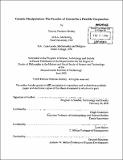Genetic manipulation : the paradox of control in a flexible corporation
Author(s)
Bentley, Patricia Peterson, 1954-
DownloadFull printable version (22.63Mb)
Other Contributors
Massachusetts Institute of Technology. Program in Science, Technology and Society.
Advisor
Hugh Gusterson.
Terms of use
Metadata
Show full item recordAbstract
This dissertation is a two-theme ethnography focusing on the early history of one company within the context of the turbulent business environment of the 1990's. One theme is the control exercised by a corporation to mold its people to achieve certain productive ends, focusing on three areas: culture, physical environment and technology. The second theme is the ability of a corporation to be flexible. Taken together, the two themes form the self-contradictory notion of trying to control a group to increase its ability to be flexible. Many writers who focus on organizations have found the biological metaphor of evolution a useful way to conceptualize some aspects of a successful firm. In contrast I find the biological metaphor of genetic manipulation best illustrates the kind of control exercised by the leadership of this particular firm. From its inception, the leadership team wanted to create a flexible firm, one that could thrive in a turbulent environment. Rather than rely on a multiplicity of heterogeneous experiments, they actively manipulated specific aspects of the firm. The early results, the formation of a successful company, suggested that those controls and the decision to actively mold the firm using such controls were the right choices. When faced with a radical change in the marketplace, the arrival of the Internet economy, the leaders of this firm responded with the same technique and once again were able to mold a successful firm. To the extent that the Internet economy requires companies to change at Internet speed, this firm's ability to manipulate its own "DNA" may well be a model for success for other firms in this environment.
Description
Thesis (Ph.D.)--Massachusetts Institute of Technology, Program in Science, Technology and Society, 2000. Includes bibliographical references (p. 399-410).
Date issued
2000Department
Massachusetts Institute of Technology. Program in Science, Technology and SocietyPublisher
Massachusetts Institute of Technology
Keywords
Program in Science, Technology and Society.